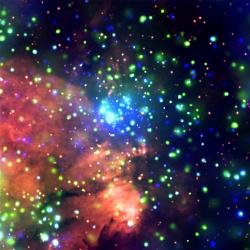 You’re looking at a star forming region known as W3. It’s located about 6,000 light-years from Earth in the Perseus arm of the Milky Way. It’s just a small part of a much larger molecular cloud complex called the W4 superbubble (not pictured here), which extends about 100 light-years across. As that superbubble expands, it’s giving these clouds of dust and gas just the bump they need to collapse and get down to the business of furious star formation.
You’re looking at a star forming region known as W3. It’s located about 6,000 light-years from Earth in the Perseus arm of the Milky Way. It’s just a small part of a much larger molecular cloud complex called the W4 superbubble (not pictured here), which extends about 100 light-years across. As that superbubble expands, it’s giving these clouds of dust and gas just the bump they need to collapse and get down to the business of furious star formation.
Continue reading “Star Formation Factory”
Supernova Remnant Acts as a Particle Accelerator
Instead of investing in particle accelerators here on Earth, physicists might consider just blowing up a few stars. New images taken by the Chandra X-Ray Observatory show how supernova remnant Cassiopeia A acts as a natural particle accelerator, firing out cosmic rays. As particles move around the remnant, they’re accelerated by the tremendous magnetic fields, eventually nearing the speed of light. The images from Chandra show that the particles are being accelerated to the maximum rate predicted by theories.
Continue reading “Supernova Remnant Acts as a Particle Accelerator”
Super-Supermassive Black Hole
The Hubble Space Telescope, the Chandra X-Ray Observatory, and the National Radio Astronomical Observatory teamed up to produce this composite image of galaxy cluster MS0735.6+7421, located about 2.5 billion light-years from Earth. The cluster contains dozens of galaxies held together by gravity. A truly supermassive black hole lurks at the heart of this cluster, containing more than a billion solar masses. The red areas are twin jets of material streaming away from the black hole.
Continue reading “Super-Supermassive Black Hole”
Nearly a Thousand Years After the Death of a Star
In 1054 A.D., Chinese astronomers recorded the temporary brightening of a star in the constellation Taurus. Nearly 1000 years later, we look in the same region and see the exploded remnants of a dead star: the Crab Nebula. This composite photograph of the Crab Nebula was made by merging images from Hubble, the Chandra X-Ray Observatory, and the Spitzer Space Telescope. It shows only a hail of high-energy particles and expanding debris cloud that once was a massive star.
Continue reading “Nearly a Thousand Years After the Death of a Star”
Black Hole Stops Star Formation in Elliptical Galaxy
New images from NASA’s Chandra X-Ray Observatory show the environment around the supermassive black hole at the heart of M87, a nearby giant elliptical galaxy. Chandra detected loops and rings in the hot gas that surrounds the galaxy. These loops are evidence of periodic eruptions near the supermassive black hole, which send shockwaves through the surrounding gas. These outbursts happen every few million years, and prevent the gas in the cluster from cooling to create stars.
Continue reading “Black Hole Stops Star Formation in Elliptical Galaxy”
Star Formation in NGC 3576
This photograph shows a star forming region in NGC 3576, located about 9,000 light years from Earth. The image was captured by NASA’s Chandra X-Ray Observatory, which reveals the higher energy emissions from the region. The blue dots are newly born stars generating ferocious solar winds (the more diffuse parts of the image). NGC 3576 is a particularly dense nebula, so many of these stars have been hidden from previous observations, until they were revealed by Chandra.
Continue reading “Star Formation in NGC 3576”
The Location of the Oldest Recorded Supernova Discovered
Ancient Chinese astronomers recorded the occurence of a bright star in the sky in 185 AD; probably a supernova explosion. And now modern astronomers think they’ve found that explosion’s corpse: supernova remnant RCW 86. New calculations have found that RCW 86 is about 2000 years old, making it the best candidate for this ancient supernova. This new data was gathered using the XMM-Newton and Chandra X-Ray observatories.
Continue reading “The Location of the Oldest Recorded Supernova Discovered”
Galaxy Collision Separates Out the Dark Matter
There’s more dark matter than regular matter in the Universe, and they’re normally all mixed up together in galaxies. But astronomers using the Chandra X-Ray Observatory have found a situation where dark matter and normal matter can be wrenched apart. In a collision between giant galaxy clusters, hot gas clouds in the clusters encounter friction as they pass through one another, separating them from the stars. The dark matter isn’t affected by this friction either, so astronomers were able to calculate the effect of its gravity on regular matter.
Continue reading “Galaxy Collision Separates Out the Dark Matter”
Chandra Confirms the Hubble Constant
Nearly every single astronomical measurement depends on the Hubble constant, a number that calculates the expansion of the Universe. NASA’s Chandra X-Ray Observatory recently measured this value independently, and came up with a similar number – 77 km per second per megaparsec (3.26 million light-years to the megaparsec). Give or take 15%. This confirms that the Universe is still between 12 and 14 billion years old.
Continue reading “Chandra Confirms the Hubble Constant”
At the Centre of the Milky Way
You’re looking at the heart of your own galaxy with X-ray specs. This photograph was captured by NASA’s Chandra X-Ray observatory, and shows the three massive star clusters that surround the supermassive black hole at the centre of the Milky Way. These star clusters have so many large, bright stars that the whole area blazes in the X-ray spectrum. This photo shows 1 million seconds of accumulated observing time by Chandra of these mysterious region of our galaxy.
Continue reading “At the Centre of the Milky Way”
